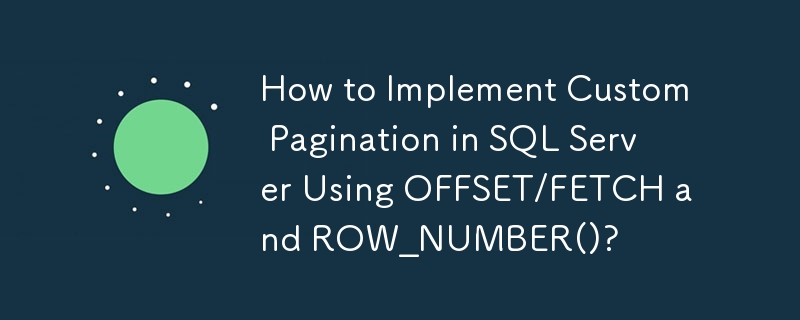 Database
Database
 Mysql Tutorial
Mysql Tutorial
 How to Implement Custom Pagination in SQL Server Using OFFSET/FETCH and ROW_NUMBER()?
How to Implement Custom Pagination in SQL Server Using OFFSET/FETCH and ROW_NUMBER()?
How to Implement Custom Pagination in SQL Server Using OFFSET/FETCH and ROW_NUMBER()?

SQL Server custom paging: OFFSET/FETCH and ROW_NUMBER() methods
SQL pagination is used to retrieve a limited number of records from a dataset and is typically used to display the results in pages on a user interface. The goal of this article is to implement paging functionality for a query that retrieves posts and their latest entries.
SQL Server 2012 and later versions can use the OFFSET and FETCH NEXT keywords to implement paging. The following query demonstrates how to use these keywords for pagination:
SELECT PostId
FROM (
SELECT PostId, MAX(Datemade) AS LastDate
FROM dbForumEntry
GROUP BY PostId
) AS SubQueryAlias
ORDER BY LastDate DESC
OFFSET 10 ROWS -- 跳过10行
FETCH NEXT 10 ROWS ONLY; -- 获取接下来的10行For versions prior to SQL Server 2012, a different approach is required. One way is to use the ROW_NUMBER() function to assign a row number to a record and then use the WHERE clause to filter the desired rows:
DECLARE @Start INT, @End INT;
SELECT @Start = 10, @End = 20;
WITH PostCTE AS (
SELECT PostId, MAX(Datemade) AS LastDate,
ROW_NUMBER() OVER (ORDER BY PostId) AS RowNumber
FROM dbForumEntry
GROUP BY PostId
)
SELECT PostId, LastDate
FROM PostCTE
WHERE RowNumber BETWEEN @Start AND @End; -- 获取第10到20行This approach provides a way to implement paging for earlier versions of SQL Server, allowing you to control the number of records displayed and facilitate navigation of large data sets.
The above is the detailed content of How to Implement Custom Pagination in SQL Server Using OFFSET/FETCH and ROW_NUMBER()?. For more information, please follow other related articles on the PHP Chinese website!

Hot AI Tools

Undresser.AI Undress
AI-powered app for creating realistic nude photos

AI Clothes Remover
Online AI tool for removing clothes from photos.

Undress AI Tool
Undress images for free

Clothoff.io
AI clothes remover

AI Hentai Generator
Generate AI Hentai for free.

Hot Article

Hot Tools

Notepad++7.3.1
Easy-to-use and free code editor

SublimeText3 Chinese version
Chinese version, very easy to use

Zend Studio 13.0.1
Powerful PHP integrated development environment

Dreamweaver CS6
Visual web development tools

SublimeText3 Mac version
God-level code editing software (SublimeText3)

Hot Topics
 1377
1377
 52
52
 How do you alter a table in MySQL using the ALTER TABLE statement?
Mar 19, 2025 pm 03:51 PM
How do you alter a table in MySQL using the ALTER TABLE statement?
Mar 19, 2025 pm 03:51 PM
The article discusses using MySQL's ALTER TABLE statement to modify tables, including adding/dropping columns, renaming tables/columns, and changing column data types.
 Explain InnoDB Full-Text Search capabilities.
Apr 02, 2025 pm 06:09 PM
Explain InnoDB Full-Text Search capabilities.
Apr 02, 2025 pm 06:09 PM
InnoDB's full-text search capabilities are very powerful, which can significantly improve database query efficiency and ability to process large amounts of text data. 1) InnoDB implements full-text search through inverted indexing, supporting basic and advanced search queries. 2) Use MATCH and AGAINST keywords to search, support Boolean mode and phrase search. 3) Optimization methods include using word segmentation technology, periodic rebuilding of indexes and adjusting cache size to improve performance and accuracy.
 How do I configure SSL/TLS encryption for MySQL connections?
Mar 18, 2025 pm 12:01 PM
How do I configure SSL/TLS encryption for MySQL connections?
Mar 18, 2025 pm 12:01 PM
Article discusses configuring SSL/TLS encryption for MySQL, including certificate generation and verification. Main issue is using self-signed certificates' security implications.[Character count: 159]
 What are some popular MySQL GUI tools (e.g., MySQL Workbench, phpMyAdmin)?
Mar 21, 2025 pm 06:28 PM
What are some popular MySQL GUI tools (e.g., MySQL Workbench, phpMyAdmin)?
Mar 21, 2025 pm 06:28 PM
Article discusses popular MySQL GUI tools like MySQL Workbench and phpMyAdmin, comparing their features and suitability for beginners and advanced users.[159 characters]
 How do you handle large datasets in MySQL?
Mar 21, 2025 pm 12:15 PM
How do you handle large datasets in MySQL?
Mar 21, 2025 pm 12:15 PM
Article discusses strategies for handling large datasets in MySQL, including partitioning, sharding, indexing, and query optimization.
 How do you drop a table in MySQL using the DROP TABLE statement?
Mar 19, 2025 pm 03:52 PM
How do you drop a table in MySQL using the DROP TABLE statement?
Mar 19, 2025 pm 03:52 PM
The article discusses dropping tables in MySQL using the DROP TABLE statement, emphasizing precautions and risks. It highlights that the action is irreversible without backups, detailing recovery methods and potential production environment hazards.
 Difference between clustered index and non-clustered index (secondary index) in InnoDB.
Apr 02, 2025 pm 06:25 PM
Difference between clustered index and non-clustered index (secondary index) in InnoDB.
Apr 02, 2025 pm 06:25 PM
The difference between clustered index and non-clustered index is: 1. Clustered index stores data rows in the index structure, which is suitable for querying by primary key and range. 2. The non-clustered index stores index key values and pointers to data rows, and is suitable for non-primary key column queries.
 Explain different types of MySQL indexes (B-Tree, Hash, Full-text, Spatial).
Apr 02, 2025 pm 07:05 PM
Explain different types of MySQL indexes (B-Tree, Hash, Full-text, Spatial).
Apr 02, 2025 pm 07:05 PM
MySQL supports four index types: B-Tree, Hash, Full-text, and Spatial. 1.B-Tree index is suitable for equal value search, range query and sorting. 2. Hash index is suitable for equal value searches, but does not support range query and sorting. 3. Full-text index is used for full-text search and is suitable for processing large amounts of text data. 4. Spatial index is used for geospatial data query and is suitable for GIS applications.




